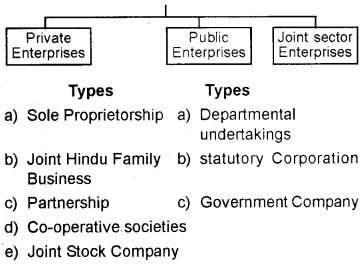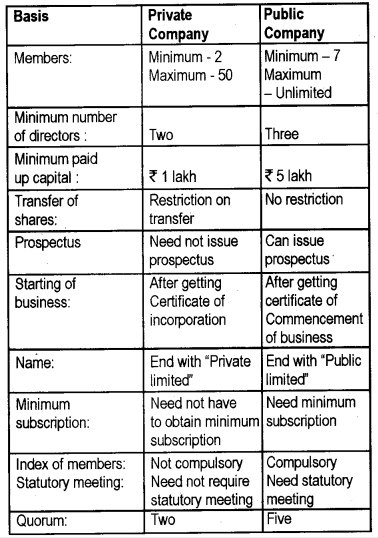Kerala Plus One Business Studies Notes Chapter 2 Forms of Business Organisation
Contets
- Sole Proprietorship – Meaning – Features Advantages & Disadvantages
- Joint Hindu Family Business (H.U.F) – Meaning – Features – Advantages & Disadvantages
- Partnership – Meaning – Features – Advantages & Disadvantages – Types of Partners – Types of Partnership – Partnership Deed – Registration
- Co operative Society – Meaning – Features Advantages & Disadvantages – Types of Co-operative Societies
- Joint Stock Company- Meaning – Features – Advantages & Disadvantages – Types of Companies-Choice of form of Business organisation
Various forms of business organisations are:
(a) Sole proprietorship,
(b) Joint Hindu family business,
(c) Partnership,
(d) Cooperative societies, and
(e) Joint stock company.

Sole proprietorship:
Sole proprietorship refers to a form of business organization which is owned, managed and controlled by an individual who is the recipient of all profits and bearer of all risks. It is the most common form of business organization.
Features:
- The sole trader is the single owner and manager of the business.
- The formation of a sole proprietorship is very easy. There are no legal formalities to form and close a sole proprietorship.
- The liability of a sole trader is unlimited, i.e. in case of loss, his personal properties can be used to pay the business liabilities.
- The entire profit of the sole trading business goes to the sole proprietor. If there is any loss it is also to be borne by the sole proprietor alone.
- The sole trader has full control over the affairs of the business. So he can take quick decisions.
- A sole trading concern has no legal existence separate from its owner.
- The death, insolvency etc. of a sole trader causes discontinuity of business.
Merits:
1. Easy formation:
The formation of a sole proprietorship is very easy. There are no legal formalities to form and close a sole proprietorship.
2. Quick Decision:
The sole trader has full control over the affairs of the business. So he can take quick decisions and prompt actions in all business matters.
3. Motivation:
The entire profit of the sole trading business goes to the sole proprietor. It motivates him to work hard.
4. Secrecy:
A sole trader can keep all the information related to business operations and he is not bound to publish firm’s accounts.
5. Close Personal Relation:
The sole proprietor can maintain good personal contact with the customers and employees and thus, business runs smoothly.
Limitations
- Limited capital: A sole trader can start business only on a small scale because of limited capital.
- Lack of Continuity: Death, insolvency or illness of a proprietor affects the business and can lead to its closure.
- Limited managerial ability: A sole proprietor may not be an expert in every aspect of management.
- Unlimited liability: The liability of a sole trader is unlimited, i.e. in case of loss, his personal properties can be used to pay off the business liabilities.
- Suitability: Sole proprietorship is suitable in the following cases.
- Where the market is limited, localized and customers demand personalized services. Eg. tailoring, beauty parlour etc.
- Where goods are unstandardized like artistic jewellery.
- Where lower capital, limited risk & limited managerial skills are required as in case of retail store.
Joint Hindu Family Business (HUF):
It refers to a form of organisation where in the business is owned and carried on by the members of a joint Hindu family. It is also known as Hindu Undivided Family Business (H.U.F). It is governed by Hindu succession Act, 1956. It is found only in India.
The business is controlled by the head of the family who is the eldest member and is called karta. All members have equal ownership right over the property of an ancestor and they are known as co-parceners.
Features
1. Formation:
For a Joint Hindu family business there should be at least two members in the family and some ancestral property to be inherited by them.
2. Membership:
Membership by virtue of birth in the family.
3. Liability:
The Karta has unlimited liability. Every other coparcener has a limited liability up to his share in the HUF property.
4. Control:
The control of the family business lies with the karta. He takes all the decisions and is authorised to manage the business.
5. Continuity:
The business is not affected by the death of the Karta as in such cases the next senior male member becomes the Karta.
6. Minor Members:
The basis of membership in the business is birth in the family. Hence, minors can also be members of the business.
Merits
1. Effective control:
The karta has absolute decision making power. This avoids conflicts among members
2. Continuity of business:
The death of the karta will not affect the business as the next eldest member will then take up the position
3. Limited liability of members:
The liability of all the co-parceners except the karta is limited to their share in the business.
4. Increased loyalty:
Members are likely to work with dedication, loyalty and care, because the work involves the family name.
Limitation
1. Limited capital:
The capital of HUF is limited since the ancestral property only can be used for the business. This reduces the scope for business growth.
2. Unlimited liability:
The liability of Karta is unlimited. His personal property can be used to repay business debts.
3. Dominance of karta:
There is a possibility of differences of opinion among the members of the Joint Family. It may affect the stability of the business.
4. Limited managerial skills:
The karta may not be an expert in all areas of management. It may affect the profitability of the business.
Partnership:
The Indian Partnership Act, 1932 defines partnership as “the relation between persons who have agreed to share the profit of the business carried on by all or any one of them acting for all.”
Features
- Formation: For the formation of a partnership, agreement between partners is essential.
- Liability: The partners of a firm have unlimited liability. The partners are jointly and individually liable for payment of debts.
- Risk bearing: The profit or loss shall be shared among the partners equally or in agreed ratio.
- Decision making and control: The activities of a partnership firm are managed through the joint efforts of all the partners.
- Lack of Continuity: The retirement, death, insolvency, insanity etc of any partner brings the firm to an end.
- Membership: There must be at least two persons to form a partnership. The maximum number of persons is ten in banking business and twenty in non banking business.
- Mutual agency: In partnership, every partner is both an agent and a principal.
Merits of Partnership:

1. Easy formation and closure:
A partnership firm can be formed and closed easily without any legal formalities.
2. Balanced decision making:
In partnership, decisions are taken by all partners. So they can take better decisions regarding their business.
3. Division of labour:
Division of labour is possible in partnership firm. Duties can be assigned to different partners according to their ability.
4. Large funds:
In a partnership, the capital is contributed by a number of partners. So they can start business on a large scale.
5. Sharing of risk:
The risks involved in running a partnership firm are shared by all the partners. This reduces the anxiety, burden and stress on individual partners..
6. Secrecy:
A partnership firm is not legally required to publish its accounts and submit its reports. Hence it can maintain confidentiality of information relating to its operations.
Limitations of Partnership:
1. Unlimited liability:
The partners of a firm have unlimited liability. The partners are jointly and individually liable for payment of debts.

2. Limited resources:
There is a restriction on the number of partners. Hence capital contributed by them is also limited.
3. Possibility of conflicts:
Lack of mutual understanding and co-operation among partners may affect the smooth working of the partnership business.
4. Lack of continuity:
The retirement, death, insolvency, insanity etc of any partner brings the firm to an end.
5. Lack of public confidence:
A partnership firm is not legally required to publish its financial reports. As a result, the confidence of the public in partnership firms is generally low.
Types of Partners:
1. Active partner:
A partner who contribute capital and takes active part in the business is called an active partner.
2. Sleeping (Dormant partner):
Partners who do not take part in the day to day activities of the business are called sleeping partners. He contributes capital, share profits and losses and has unlimited liability.
3. Secret partner:
A secret partner is one whose association with the firm is unknown to the general public. He contributes to the capital, takes part in the management, shares its profits and losses, and has unlimited liability.
4. Nominal partner (Quasi Partner):
A nominal partner neither contributes capital nor takes any active part in the management of the business. He simply lend his name to the firm. But, he is liable to third parties for all the debts of the firm.
5. Partner by estoppel:
If a partner by his talk or action leads others to believe that he is a partner in a firm, then he is known as partner by estoppel. However, he is liable to third parties.
6. Partner by holding out:
if a partner declares that a particular person is a partner of their firm, and such a person does not disclaim it, then he/she is known as ‘Partner by Holding out’. Such partners are not entitled to profits but are liable to third parties.
7. Minor Partner:
A minor can be admitted to the benefits of a partnership firm with the mutual consent of all other partners. In such cases, his liability will be limited to the extent of the capital contributed by him.
He will not be eligible to take an active part in the management of the firm. But, a minor can share only the profits and cannot be asked to bear the losses. However, he can inspect the accounts of the firm.

Types of Partnerships:
On the basis of duration, there are two types of partnerships:
- Partnership at will
- Particular partnership
1. Partnership at will:
This type of partnership exists at the will of the partners. It can continue as long as the partners want and is terminated when any partner gives a notice of withdrawal from partnership to the firm.
2. Particular partnership:
Partnership formed for the accomplishment of a particular project or for a specified time period is called particular partnership.
On the basis of liability, the two types of partnerships are:
- General partnership
- Limited partnership
1. General Partnership:
In general partnership, the liability of partners is joint and unlimited. Registration of the firm is optional. The existence of the firm is affected by the death, lunacy, insolvency or retirement of the partners.
2. Limited Partnership:
In limited partnership, the liability of at least one partner is unlimited whereas the rest may have limited liability. Registration of such partnership is compulsory. Such a partnership does not get terminated with the death, lunacy or insolvency of the limited partners. This form of partnership is permitted in India after the introduction of Small Enterprise Policy in 1991.
Partnership Deed:
The written agreement which specifies the terms and conditions that govern the partnership is called the partnership deed;
Contents
- Name of firm
- Nature of business and location of business
- Duration of business
- Investment made by each partner
- Profit sharing ratio
- Rights, duties and powers of the partners
- Salaries and withdrawals of the partners
- Terms governing admission, retirement and expulsion of a partner
- Interest on capital and interest on drawings
- Procedure for dissolution of the firm
- Preparation of accounts and their auditing
- Method of solving disputes
Registration of partnership:
According to Indian Partnership Act 1932, registration of a partnership is not compulsory, it is optional. However, they can register with the Registrar of firms of the state in which the firm is situated.
Procedure for Registration:
- 1. Submission of application in the prescribed form to the Registrar of firms. The application should contain the following particulars:
- Name of the firm
- Location of the firm
- Names of other places where the firm carries on business
- The date when each partner joined the firm
- Names and addresses of the partners
- Duration of partnership. This application should be signed by all the partners.
- Deposit of required fees with the Registrar of Firms.
- The Registrar after approval will make an entry in the register of firms and will subsequently issue a certificate of registration. The consequences of non-registration of a firm are as follows:
- A partner of an unregistered firm cannot file suit against the firm or other partner.
- The firm cannot file a suit against third party.
- The firm cannot file a case against its partner.
Co-operative Society:
A cooperative society is a voluntary association of persons, who join together with the motive of welfare of the members. The basis of co-operation is self help through mutual help, the motto is “each for all and all for each”.
The cooperative society is compulsorily required to be registered under the Cooperative Societies Act 1912. At least ten persons are required to form a society. The capital of a society is raised from its members through issue of shares.
Features:
The important features of a co-operative society are:
- Voluntary membership: The membership of a cooperative society is voluntary. Membership is open to all, irrespective of their religion, caste, and gender.
- Legal status: Registration of a cooperative society is compulsory.
- Limited liability: The liability of the members of a cooperative society is limited to the extent of the amount contributed by them as capital.
- Control: Management and control lies with the managing committee elected by the members.
- Service motive: ‘Self help through mutual help’ or ‘each for all and’ all for each’ is the foundation of co-operative society.
Merits:

- Equality in voting status: The principle of ‘one man one vote’governs the cooperative society.
- Limited liability: The liability of members of a cooperative society is limited to the extent of their capital contribution.
- Stable existence: Death, insolvency or insanity of the members do not affect continuity of a cooperative society.
- Economy in operations: Co-operative society aims to eliminate middlemen. This helps in reducing cost.
- Support from government: A co-operative society gets support from the government in the form of low taxes, subsidies and low interest rates on loans.
- Easy formation: The cooperative society can be started with a minimum often members. Its registration procedure is simple involving a few legal formalities
Limitations:

1. Limited resources:
Resources of a cooperative society consists of limited capital contributions of the members.
2. Inefficiency in management:
Cooperative societies are unable to attract and employ expert managers because of their inability to pay them high salaries.
3. Lack of secrecy:
As a result of open discussions in the meetings of members it is difficult to maintain secrecy about the operations of a cooperative society.’
4. Government control:
cooperative societies have to comply with several rules and regulations related to auditing of accounts, submission of accounts, etc. It affects its freedom of operations.
5. Differences of opinion:
The different viewpoints of members in a co-operative society may lead to difficulties in decision making.
Types of co-operative society:
1. Consumer’s cooperative societies:
The consumer cooperative societies are formed to protect the interests of consumers. The society aims at eliminating middlemen to achieve economy in operations. It purchases goods in bulk directly from the wholesalers and sells goods to the members at the lowest price.
2. Producer’s cooperative societies:
These societies are set up to protect the interest of small producers. It supplies raw materials, equipment and other inputs to the members and also buys their output for sale.
3. Marketing cooperative societies:
Such societies are established to help small producers in selling their Products. It collects the output of individual members and sell them at the best possible price. Profits are distributed to members.
4. Farmer’s cooperative societies:
These societies . are established to protect the interests of farmers by providing better inputs at a reasonable cost. Such societies provide better quality seeds, fertilizers, machinery and other modern techniques for use in the cultivation of crops.
5. Credit cooperative societies:
Credit cooperative societies are established for providing easy credit on reasonable terms to the members. Such societies provide loans to members at low rates of interest.
Joint Stock company:
A company may be defined as a voluntary association of persons having a separate legal entity, with perpetual succession and a common seal. It is an artificial person created by law. The companies in India are governed by the Indian . Companies Act, 1956.
The capital of the company is divided into smaller parts called ‘shares’ which can be transferred freely, (except in a private company). The shareholders are the owners of the company. The company is managed by Board of Directors, elected by shareholders.
Features:
1. Incorporated association:
A company is an incorporated association, i.e. Registration of a company is compulsory under the Indian Companies Act, 1956.
2. Separate legal entity:
A company is an artificial person created by law. Company has a separate legal entity apart from its members. It can enter into contracts, own property, sue and be sued, borrow and lend money etc.
3. Formation:
The formation of a company is a time consuming, expensive and complicated process.
4. Perpetual succession:
A company has a continuous existence. Its existence not affected by death, insolvency or insanity of shareholders. Members may come and go, but the company continues to exist.
5. Control:
The management and control of the affairs of the company is in the hands of Board of directors who are elected the representatives of the shareholders.
6. Liability:
The liability of the shareholders is limited to the extent of the face value of shares held by them.
7. Common seal:
The Company being an artificial person acts through its Board of Directors. All documents issued by the company must be authenticated by the company seal.
8. Transferability of shares:
Shares of a joint stock company are freely transferable except in case of a private company.
Merits:

1. Limited liability:
The liability of the shareholders is limited to the extent of the face value of shares held by them. This reduces the degree of risk borne by an investor.
2. Transferability of shares:
Shares of a public company are freely transferable . It provides liquidity to the investor.z
3. Perpetual existence:
A company has a continuous existence. Its existence not affected by death, insolvency or insanity of shareholders.
4. Scope for expansion:
A company has large financial resources. So it can start business on a large scale.
5. Professional management:
A company can afford to pay higher salaries to specialists and professionals. This leads to greater efficiency in the company’s operations.
6. Public confidence:
A company must publish its audited annual accounts. So it enjoys public confidence.
Limitations:

1. Difficulty in formation:
The formation of a company is very difficult. It requires greater time, effort and extensive knowledge of legal requirements.
2. Lack of secrecy:
It is very difficult to maintain secrecy in case of public company, as company is required to publish its annual accounts and reports.
3. Impersonal work:
It is difficult for the owners and top management to maintain personal contact with the employees, customers and creditors.
4. Numerous regulations:
The functioning of a company is subject to many legal provisions and compulsions. This reduces the freedom of operations of a company.
5 Delay in decision making:
A company takes important decisions by holding company meetings. It requires a lot of time.
6. Oligarchic management:
Theoretically, a company is democratically managed but actually it is managed by few people, i.e board of directors. The Board of Directors enjoy considerable freedom in exercising their power which they sometimes ignore the interest of the shareholders.
7. Conflict in interests:
There may be conflict of interest amongst various stakeholders of a company. It affects the smooth functioning of the company.
8. Lack of motivation:
The company is managed by board of directors. They have little interest to protect the interest of the company.
Types of Companies:
A company can be either a private or a public company.
Private Company:
A private company means a company which:
- restricts the right of members to transfer its shares
- has a minimum of 2 and a maximum of 50 members
- does not invite public to subscribe to its share capital
- must have a minimum paid up capital of Rs.1 lakh
It is necessary for a private company to use the word private limited after its name.
Privileges of a private company:
- A private company can be formed by only two members.
- There is no need to issue a prospectus
- Allotment of shares can be done without receiving the minimum subscription.
- A private company can start business as soon . as it receives the certificate of incorporation.
- A private company needs to have only two directors.
- A private company is not required to keep an index of members.
- There is no restriction on the amount of loans to directors in a private company.
Public Company:
A public company means a company which is not a private company. As perthe Indian Companies Act, a public company is one which:
- has a minimum paid-up capital of Rs. 5 lakhs
- has a minimum of 7 members and no limit on maximum members
- can transfer its shares
- can invite the public to subscribe to its shares.
A private company which is a subsidiary of a public company is also treated as a public company. A public company’must use the word limited after its name
Difference between a public company and private company:

A Comparative assessment of different forms of business organisation:

Choice of business organisation:
The important factors determining the choice of organization are:
1. Cost and Ease of formation:
From the point of view of cost, sole proprietorship is the preferred form as it involves least expenditure and the legal requirements are minimum. Company form of organisation, is more complex and involves greater costs.
2. Liability:
In case of sole proprietorship and partnership firms, the liability of the owners/ partners is unlimited. In cooperative societies and companies, the liability is limited. Hence, from the point of view of investors, the company form of organisation is more suitable as the risk involved is limited.
3. Continuity:
The continuity of sole proprietorship and partnership firms is affected by death, insolvency or insanity of the owners. However, such factors do not affect the continuity of cooperative societies and companies. In case the business needs a permanent structure, company form is more suitable.
4. Management ability:
If the organisation’s operations are complex in nature and require professionalized management, company form of organisation is a better alternative.
5. Capital:
If the scale of operations is large, company form may be suitable whereas for medium and small sized business one can opt for partnership or sole proprietorship.
6. Degree of control:
If direct control over business and decision making power is required, proprietorship may be preferred. But if the owners do not mind sharing control and decision making, partnership or company form of organisation can be adopted.
7. Nature of business:
If direct personal contact is needed with the customers, Sole proprietorship may be more suitable. Otherwise, the company form of organisation may be adopted.
